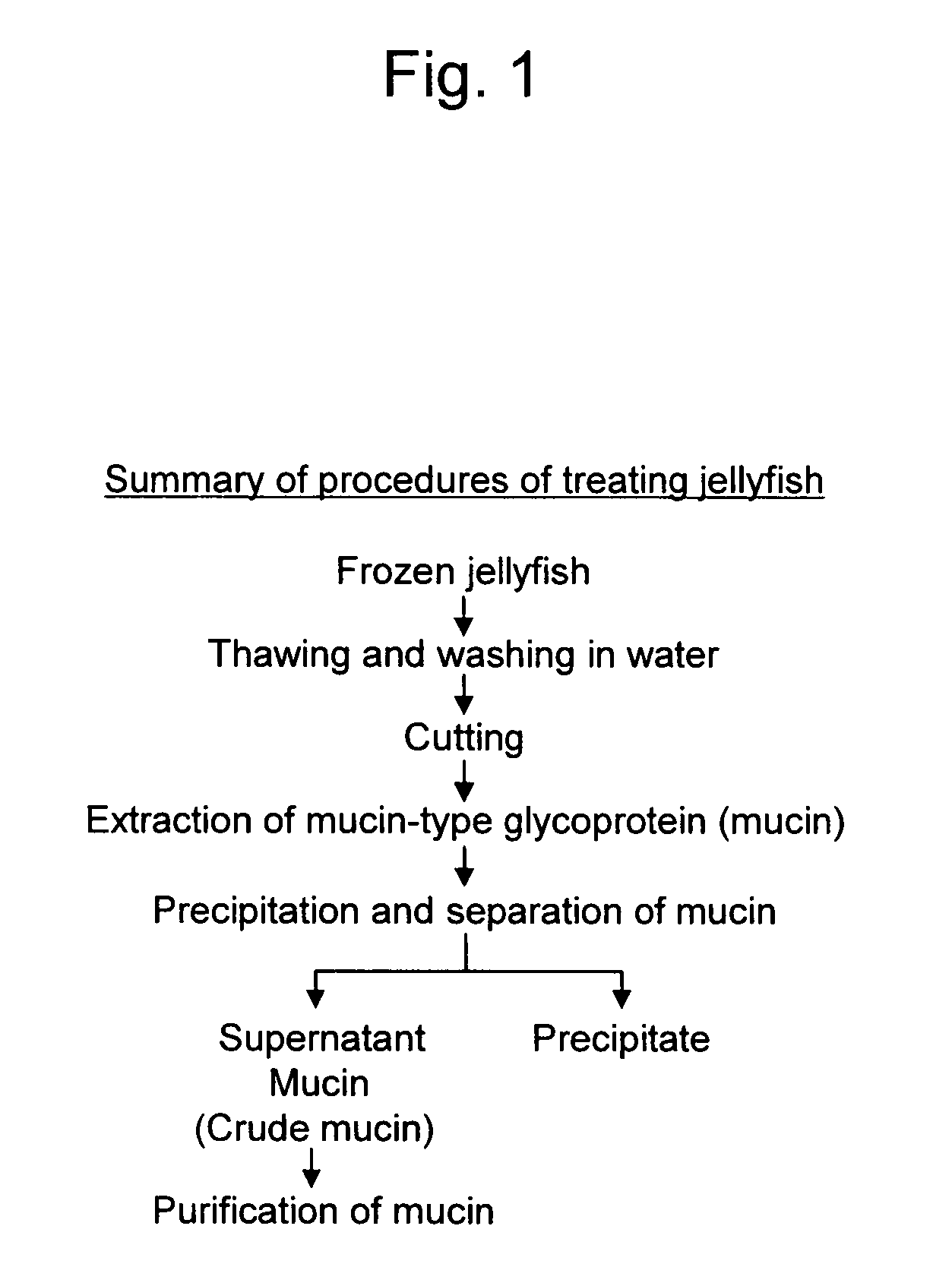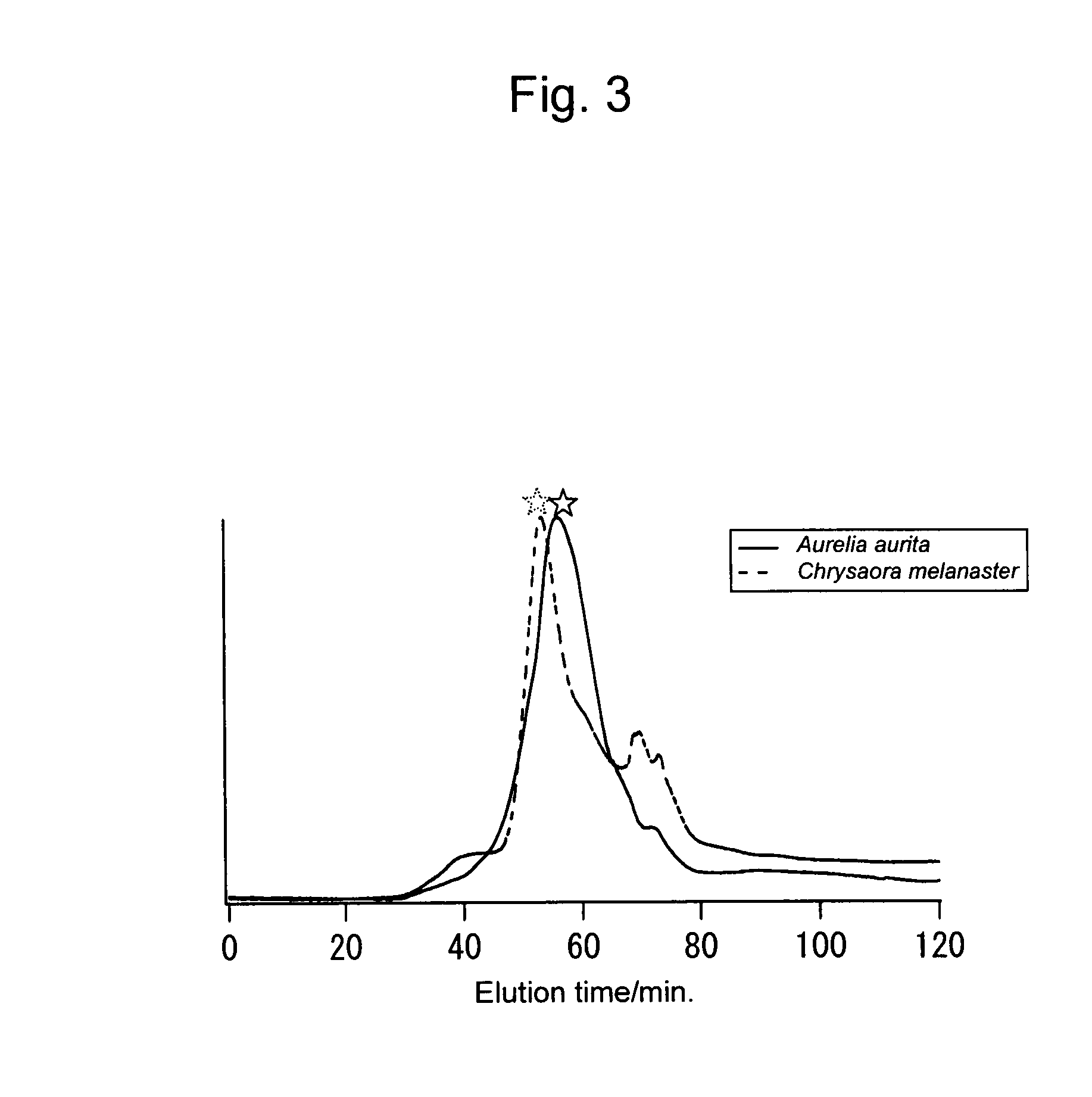Mucin-type glycoprotein and use thereof
a mucin-type glycoprotein and mucin-type technology, applied in the field of mucin-type glycoproteins, can solve the problems of unsuitable large-scale production, unsuitable gene transfer or cloning approaches, and undiscovered appropriate methods for synthesizing them, and achieve superior economic and environmental preservation techniques, and easy production in large quantities.
- Summary
- Abstract
- Description
- Claims
- Application Information
AI Technical Summary
Benefits of technology
Problems solved by technology
Method used
Image
Examples
example 1
[0135]Crude mucin serving as a precursor of a novel mucin-type glycoprotein according to the present invention was extracted from moon jelly (Aurelia aurita) and brown jellyfish (Chrysaora melanaster) by the following method, as shown in FIG. 2:[0136]1) A whole jellyfish in a frozen state was thawed and then washed in water, and solid matter and liquid were separated by centrifugation;[0137]2) The remaining solid portion was cut into fragments of approximately 5 mm to 1 cm square with scissors;[0138]3) The fragments were subjected to degreasing and dehydration by acetone treatment and then swollen with water;[0139]4) The solid sample was added to a 0.2% NaCl aqueous solution and subjected to extraction by shaking at 4° C.;[0140]5) The solution from step 4 was centrifuged at 4° C. at 10000 g for 15 minutes;[0141]6) To the extracts from step 5, 3-fold volume of ethanol was added to give precipitates in a gel form;[0142]7) The solution from step 6 was left standing overnight in a refri...
example 2
[0146]The crude mucins from two jellyfishes obtained in Example 1 were subjected to ion-exchange liquid chromatography, and peaks with asterisks shown in FIG. 3 were purified to thereby obtain mucin-type glycoproteins with high purity.
[0147]Conditions for chromatography used are as follows:
[0148]TSK gel DEAE-ToyoPearl 650M 25 mm i.d.×150 mm
[0149]A: 10 mMNaPi, pH 7
[0150]B: 0.5 M NaCl / 10 mM NaPi, pH 7
[0151]flow 2 ml / min, detector UV (215 nm)
[0152]gradient 0-60 min (% B: 0-100)
[0153]sample: Moon jelly (Aurelia aurita)[0154]5 ml (2 mg / ml crude mucin / 10 mM NaPi solution)
[0155]Brown jellyfish (Chrysaora melanaster)[0156]1.3 ml
example 3
[0157]The compounds purified in Example 2 were subjected to constituent amino acid analysis using an automatic amino acid analyzer. Each of the samples (approximately 12 μg each) purified by ion-exchange chromatography and dialyzed as described above was transferred to a hydrolysis tube and evaporated to dryness with a centrifuge evaporator. The dried sample was placed in an outer tube containing constant boiling hydrochloric acid (5.7 N) and sealed under reduced pressure. Hydrolysis was performed at 110° C. for 20 hours by a gas phase method.
[0158]The outer tube was opened, and the hydrolysis tube was subjected to drying in the same way. The dried hydrolysate was dissolved in 100 μl of 0.02 N hydrochloric acid. A high-speed amino acid analyzer L-8500A (manufactured by Hitachi Ltd.) was used in the amino acid analysis of the hydrolysate. The amino acids in the hydrolysate were separated with five buffer solutions using an ion-exchange column according to the special amino acid analy...
PUM
| Property | Measurement | Unit |
|---|---|---|
| temperature | aaaaa | aaaaa |
| temperature | aaaaa | aaaaa |
| molecular weight | aaaaa | aaaaa |
Abstract
Description
Claims
Application Information
 Login to View More
Login to View More - R&D
- Intellectual Property
- Life Sciences
- Materials
- Tech Scout
- Unparalleled Data Quality
- Higher Quality Content
- 60% Fewer Hallucinations
Browse by: Latest US Patents, China's latest patents, Technical Efficacy Thesaurus, Application Domain, Technology Topic, Popular Technical Reports.
© 2025 PatSnap. All rights reserved.Legal|Privacy policy|Modern Slavery Act Transparency Statement|Sitemap|About US| Contact US: help@patsnap.com



